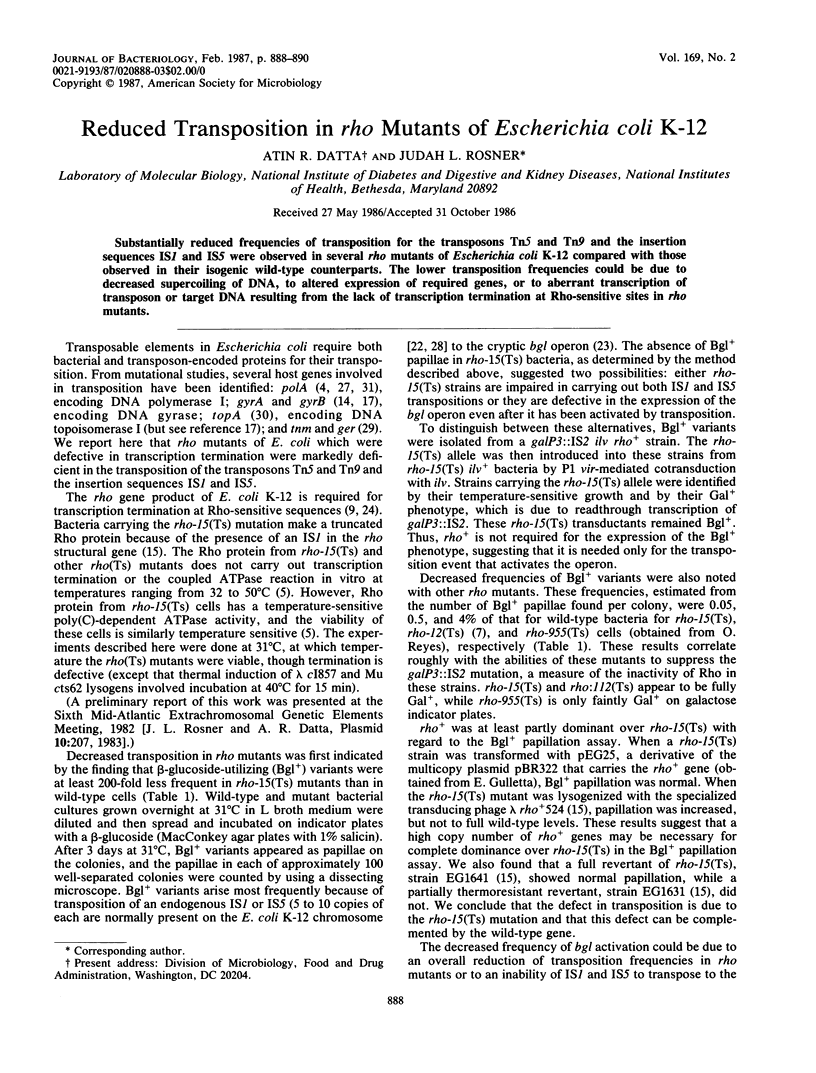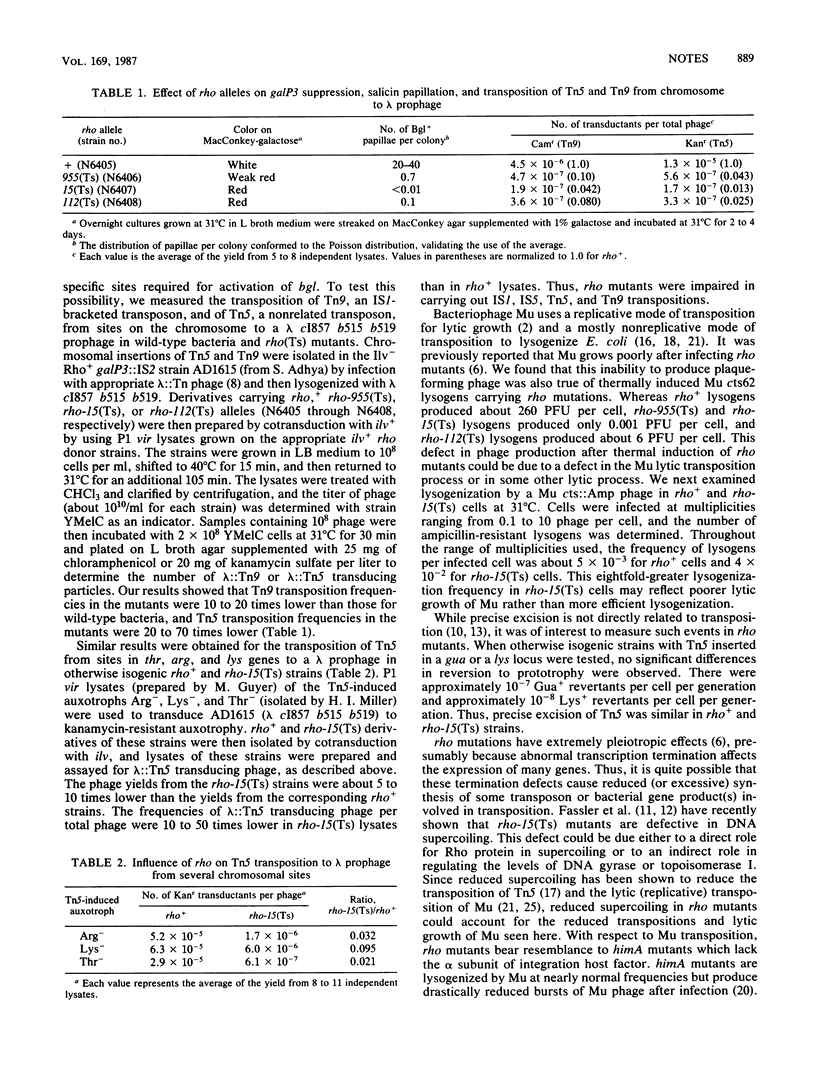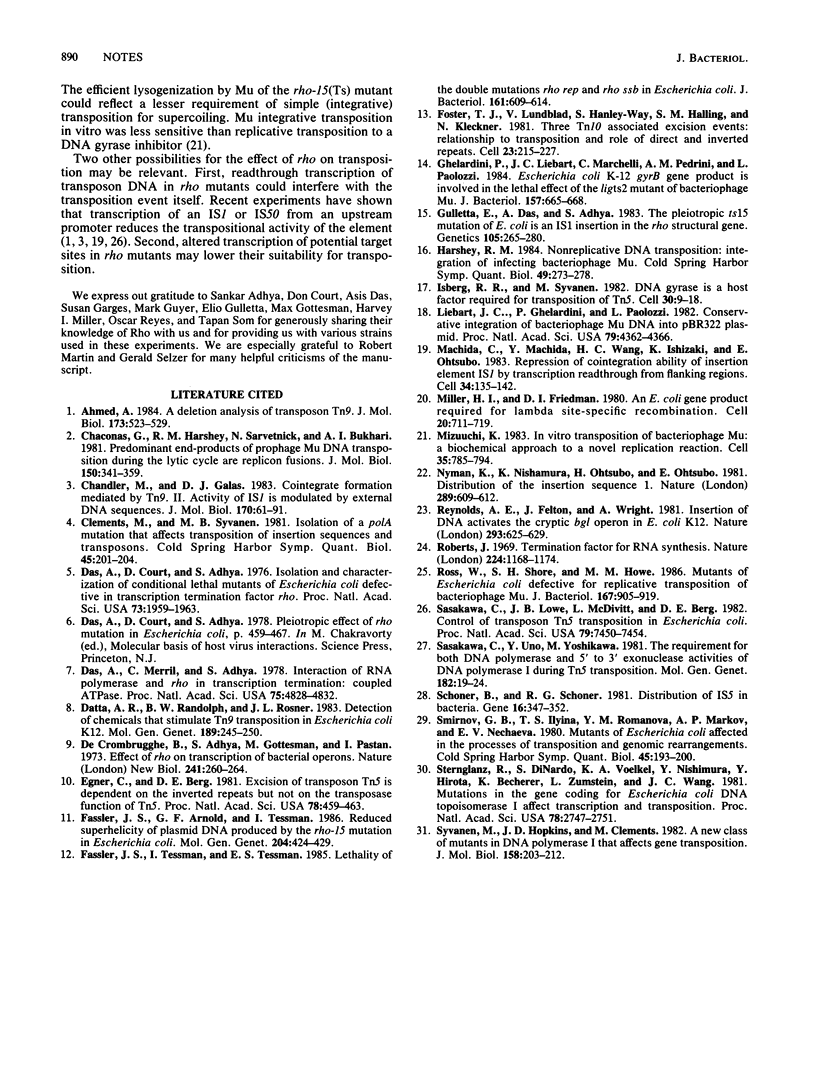Abstract
Substantially reduced frequencies of transposition for the transposons Tn5 and Tn9 and the insertion sequences IS1 and IS5 were observed in several rho mutants of Escherichia coli K-12 compared with those observed in their isogenic wild-type counterparts. The lower transposition frequencies could be due to decreased supercoiling of DNA, to altered expression of required genes, or to aberrant transcription of transposon or target DNA resulting from the lack of transcription termination at Rho-sensitive sites in rho mutants.
Full text
PDF


Selected References
These references are in PubMed. This may not be the complete list of references from this article.
- Ahmed A. A deletion analysis of transposon Tn9. J Mol Biol. 1984 Mar 15;173(4):523–529. doi: 10.1016/0022-2836(84)90395-4. [DOI] [PubMed] [Google Scholar]
- Chaconas G., Harshey R. M., Sarvetnick N., Bukhari A. I. Predominant end-products of prophage Mu DNA transposition during the lytic cycle are replicon fusions. J Mol Biol. 1981 Aug 15;150(3):341–359. doi: 10.1016/0022-2836(81)90551-9. [DOI] [PubMed] [Google Scholar]
- Chandler M., Galas D. J. Cointegrate formation mediated by Tn9. II. Activity of IS1 is modulated by external DNA sequences. J Mol Biol. 1983 Oct 15;170(1):61–91. doi: 10.1016/s0022-2836(83)80227-7. [DOI] [PubMed] [Google Scholar]
- Clements M. B., Syvanen M. Isolation of polA mutation that affects transposition of insertion sequences and transposons. Cold Spring Harb Symp Quant Biol. 1981;45(Pt 1):201–204. doi: 10.1101/sqb.1981.045.01.032. [DOI] [PubMed] [Google Scholar]
- Das A., Court D., Adhya S. Isolation and characterization of conditional lethal mutants of Escherichia coli defective in transcription termination factor rho. Proc Natl Acad Sci U S A. 1976 Jun;73(6):1959–1963. doi: 10.1073/pnas.73.6.1959. [DOI] [PMC free article] [PubMed] [Google Scholar]
- Das A., Merril C., Adhya S. Interaction of RNA polymerase and rho in transcription termination: coupled ATPase. Proc Natl Acad Sci U S A. 1978 Oct;75(10):4828–4832. doi: 10.1073/pnas.75.10.4828. [DOI] [PMC free article] [PubMed] [Google Scholar]
- Datta A. R., Randolph B. W., Rosner J. L. Detection of chemicals that stimulate Tn9 transposition in Escherichia coli K12. Mol Gen Genet. 1983;189(2):245–250. doi: 10.1007/BF00337812. [DOI] [PubMed] [Google Scholar]
- De Crombrugghe B., Adhya S., Gottesman M., Pastan I. Effect of Rho on transcription of bacterial operons. Nat New Biol. 1973 Feb 28;241(113):260–264. doi: 10.1038/newbio241260a0. [DOI] [PubMed] [Google Scholar]
- Egner C., Berg D. E. Excision of transposon Tn5 is dependent on the inverted repeats but not on the transposase function of Tn5. Proc Natl Acad Sci U S A. 1981 Jan;78(1):459–463. doi: 10.1073/pnas.78.1.459. [DOI] [PMC free article] [PubMed] [Google Scholar]
- Fassler J. S., Arnold G. F., Tessman I. Reduced superhelicity of plasmid DNA produced by the rho-15 mutation in Escherichia coli. Mol Gen Genet. 1986 Sep;204(3):424–429. doi: 10.1007/BF00331019. [DOI] [PubMed] [Google Scholar]
- Fassler J. S., Tessman I., Tessman E. S. Lethality of the double mutations rho rep and rho ssb in Escherichia coli. J Bacteriol. 1985 Feb;161(2):609–614. doi: 10.1128/jb.161.2.609-614.1985. [DOI] [PMC free article] [PubMed] [Google Scholar]
- Foster T. J., Lundblad V., Hanley-Way S., Halling S. M., Kleckner N. Three Tn10-associated excision events: relationship to transposition and role of direct and inverted repeats. Cell. 1981 Jan;23(1):215–227. doi: 10.1016/0092-8674(81)90286-5. [DOI] [PubMed] [Google Scholar]
- Ghelardini P., Liebart J. C., Marchelli C., Pedrini A. M., Paolozzi L. Escherichia coli K-12 gyrB gene product is involved in the lethal effect of the ligts2 mutant of bacteriophage Mu. J Bacteriol. 1984 Feb;157(2):665–668. doi: 10.1128/jb.157.2.665-668.1984. [DOI] [PMC free article] [PubMed] [Google Scholar]
- Gulletta E., Das A., Adhya S. The pleiotropic ts15 mutation of E. coli is an IS1 insertion in the rho structural gene. Genetics. 1983 Oct;105(2):265–280. doi: 10.1093/genetics/105.2.265. [DOI] [PMC free article] [PubMed] [Google Scholar]
- Harshey R. M. Nonreplicative DNA transposition: integration of infecting bacteriophage mu. Cold Spring Harb Symp Quant Biol. 1984;49:273–278. doi: 10.1101/sqb.1984.049.01.032. [DOI] [PubMed] [Google Scholar]
- Isberg R. R., Syvanen M. DNA gyrase is a host factor required for transposition of Tn5. Cell. 1982 Aug;30(1):9–18. doi: 10.1016/0092-8674(82)90006-x. [DOI] [PubMed] [Google Scholar]
- Liebart J. C., Ghelardini P., Paolozzi L. Conservative integration of bacteriophage Mu DNA into pBR322 plasmid. Proc Natl Acad Sci U S A. 1982 Jul;79(14):4362–4366. doi: 10.1073/pnas.79.14.4362. [DOI] [PMC free article] [PubMed] [Google Scholar]
- Machida C., Machida Y., Wang H. C., Ishizaki K., Ohtsubo E. Repression of cointegration ability of insertion element IS1 by transcriptional readthrough from flanking regions. Cell. 1983 Aug;34(1):135–142. doi: 10.1016/0092-8674(83)90143-5. [DOI] [PubMed] [Google Scholar]
- Miller H. I., Friedman D. I. An E. coli gene product required for lambda site-specific recombination. Cell. 1980 Jul;20(3):711–719. doi: 10.1016/0092-8674(80)90317-7. [DOI] [PubMed] [Google Scholar]
- Mizuuchi K. In vitro transposition of bacteriophage Mu: a biochemical approach to a novel replication reaction. Cell. 1983 Dec;35(3 Pt 2):785–794. doi: 10.1016/0092-8674(83)90111-3. [DOI] [PubMed] [Google Scholar]
- Nyman K., Nakamura K., Ohtsubo H., Ohtsubo E. Distribution of the insertion sequence IS1 in gram-negative bacteria. Nature. 1981 Feb 12;289(5798):609–612. doi: 10.1038/289609a0. [DOI] [PubMed] [Google Scholar]
- Reynolds A. E., Felton J., Wright A. Insertion of DNA activates the cryptic bgl operon in E. coli K12. Nature. 1981 Oct 22;293(5834):625–629. doi: 10.1038/293625a0. [DOI] [PubMed] [Google Scholar]
- Roberts J. W. Termination factor for RNA synthesis. Nature. 1969 Dec 20;224(5225):1168–1174. doi: 10.1038/2241168a0. [DOI] [PubMed] [Google Scholar]
- Ross W., Shore S. H., Howe M. M. Mutants of Escherichia coli defective for replicative transposition of bacteriophage Mu. J Bacteriol. 1986 Sep;167(3):905–919. doi: 10.1128/jb.167.3.905-919.1986. [DOI] [PMC free article] [PubMed] [Google Scholar]
- Sasakawa C., Lowe J. B., McDivitt L., Berg D. E. Control of transposon Tn5 transposition in Escherichia coli. Proc Natl Acad Sci U S A. 1982 Dec;79(23):7450–7454. doi: 10.1073/pnas.79.23.7450. [DOI] [PMC free article] [PubMed] [Google Scholar]
- Sasakawa C., Uno Y., Yoshikawa M. The requirement for both DNA polymerase and 5' to 3' exonuclease activities of DNA polymerase I during Tn5 transposition. Mol Gen Genet. 1981;182(1):19–24. doi: 10.1007/BF00422761. [DOI] [PubMed] [Google Scholar]
- Schoner B., Schoner R. G. Distribution of IS5 in bacteria. Gene. 1981 Dec;16(1-3):347–352. doi: 10.1016/0378-1119(81)90093-7. [DOI] [PubMed] [Google Scholar]
- Smirnov G. B., Ilyina T. S., Romanova Y. M., Markov A. P., Nechaeva E. V. Mutants of Escherichia coli affected in the processes of transposition and genomic rearrangements. Cold Spring Harb Symp Quant Biol. 1981;45(Pt 1):193–200. doi: 10.1101/sqb.1981.045.01.031. [DOI] [PubMed] [Google Scholar]
- Sternglanz R., DiNardo S., Voelkel K. A., Nishimura Y., Hirota Y., Becherer K., Zumstein L., Wang J. C. Mutations in the gene coding for Escherichia coli DNA topoisomerase I affect transcription and transposition. Proc Natl Acad Sci U S A. 1981 May;78(5):2747–2751. doi: 10.1073/pnas.78.5.2747. [DOI] [PMC free article] [PubMed] [Google Scholar]
- Syvanen M., Hopkins J. D., Clements M. A new class of mutants in DNA polymerase I that affects gene transposition. J Mol Biol. 1982 Jun 25;158(2):203–212. doi: 10.1016/0022-2836(82)90429-6. [DOI] [PubMed] [Google Scholar]


